

Heinz Ketchup Copycat Recipe. Wiki: Cabbage. Cabbage (Brassica oleracea or variants) is a leafy green or purple biennial plant, grown as an annual vegetable crop for its dense-leaved heads.
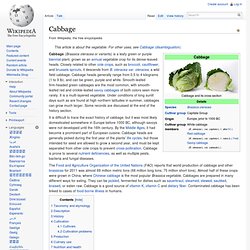
Closely related to other cole crops, such as broccoli, cauliflower, and brussels sprouts, it descends from B. oleracea var. oleracea, a wild field cabbage. Cabbage heads generally range from 0.5 to 4 kilograms (1 to 9 lb), and can be green, purple and white. Smooth-leafed firm-headed green cabbages are the most common, with smooth-leafed red and crinkle-leafed savoy cabbages of both colors seen more rarely. It is a multi-layered vegetable. Under conditions of long sunlit days such as are found at high northern latitudes in summer, cabbages can grow much larger. It is difficult to trace the exact history of cabbage, but it was most likely domesticated somewhere in Europe before 1000 BC, although savoys were not developed until the 16th century. Taxonomy and etymology[edit] Description[edit] History[edit] Green and purple cabbages.
Wiki: Celery. Etymology[edit] Leaf celery Taxonomy[edit] Celery was described by Carl Linnaeus in Volume One of his Species Plantarum in 1753.[6] Cultivation[edit]
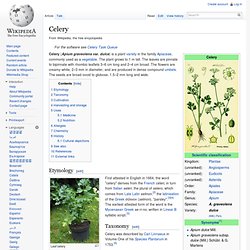
Wiki: Cucumber. Description Flowering and pollination A few cultivars of cucumber are parthenocarpic, the blossoms creating seedless fruit without pollination.
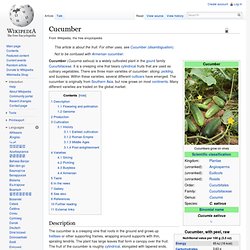
Pollination for these cultivars degrades the quality. Wiki: Mushroom. "Mushroom" describes a variety of gilled fungi, with or without stems, and the term is used even more generally, to describe both the fleshy fruiting bodies of some Ascomycota and the woody or leathery fruiting bodies of some Basidiomycota, depending upon the context of the word.
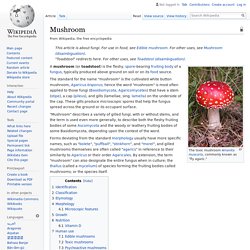
Identification Morphological characteristics of the caps of mushrooms Identifying mushrooms requires a basic understanding of their macroscopic structure. Most are Basidiomycetes and gilled. Wiki: Potato. The potato is a starchy, tuberous crop from the perennial nightshade Solanum tuberosum L.
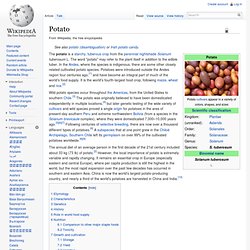
The word "potato" may refer to the plant itself in addition to the edible tuber. In the Andes, where the species is indigenous, there are some other closely related cultivated potato species. Potatoes were introduced outside the Andes region four centuries ago,[1] and have become an integral part of much of the world's food supply. It is the world's fourth-largest food crop, following maize, wheat and rice.[2] The annual diet of an average person in the first decade of the 21st century included about 33 kg (73 lb) of potato.[2] However, the local importance of potato is extremely variable and rapidly changing.
Etymology The English word potato comes from Spanish patata (the name used in Spain). Wiki: Romaine Lettuce. Romaine lettuce Romaine Lettuce heart cross section Romaine or cos lettuce is a variety of lettuce (Lactuca sativa L. var. longifolia) which grows in a tall head of sturdy leaves with firm ribs down their centers.
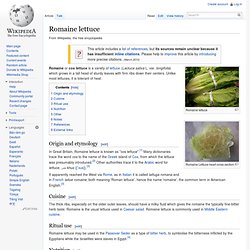
Wiki: Spinach. Spinach (Spinacia oleracea) is an edible flowering plant in the family of Amaranthaceae.

It is native to central and southwestern Asia. It is an annual plant (rarely biennial), which grows to a height of up to 30 cm. Spinach may survive over winter in temperate regions. Wiki: (Squash) Cucurbita. Most Cucurbita species are vines, grow several meters in length, have yellow or orange flowers, and may have tendrils.
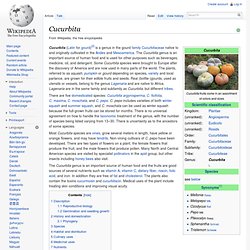
Non-vining cultivars of C. pepo have been developed. There are two types of flowers on a plant, the female flowers that produce the fruit, and the male flowers that produce pollen. Many North and Central American species are visited by specialist pollinators in the apid group, but other insects including honey bees also visit.
Wiki: Sweet Potato. The sweet potato (Ipomoea batatas) is a dicotyledonous plant that belongs to the morning glory family Convolvulaceae.
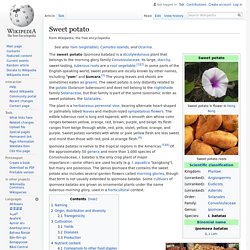
Its large, starchy, sweet-tasting, tuberous roots are a root vegetable.[1][2] In some parts of the English-speaking world, sweet potatoes are locally known by other names, including "yam" and kumara.[3] The young leaves and shoots are sometimes eaten as greens.
Carrots. Garlic. Ginger. Onions. Tomatoes. Wiki: Beetroot. Beetroots at a grocery store Beetroot on a plate The beetroot, also known in North America as the table beet, garden beet, red or golden beet, or informally simply as the beet, is any of the cultivated varieties of beet (Beta vulgaris) grown for their edible taproots, especially B. vulgaris L. subsp. conditiva.[1] They are among the most commonly encountered varieties in North America, Central America, and Europe.
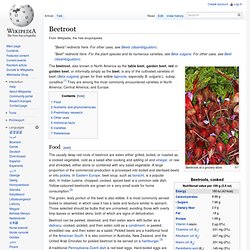
Food[edit] The usually deep red roots of beetroot are eaten either grilled, boiled, or roasted as a cooked vegetable, cold as a salad after cooking and adding oil and vinegar, or raw and shredded, either alone or combined with any salad vegetable. A large proportion of the commercial production is processed into boiled and sterilised beets or into pickles. The green, leafy portion of the beet is also edible. A traditional Pennsylvania Dutch dish is red beet eggs. Beetroot can also be used to make wine.[5] Nutrients and phytochemicals[edit] Preliminary research[edit]